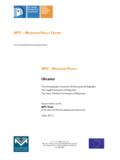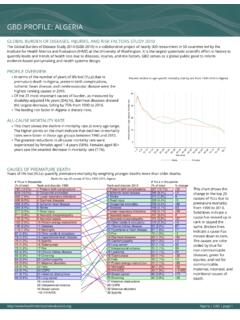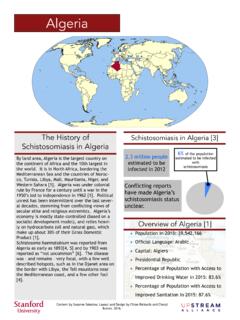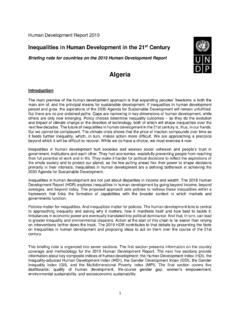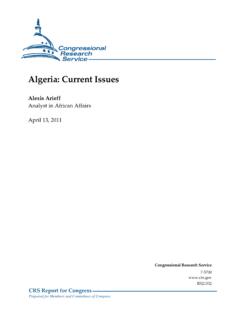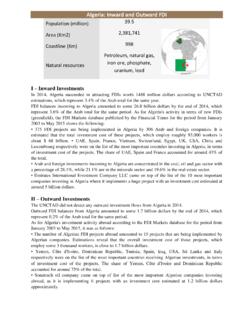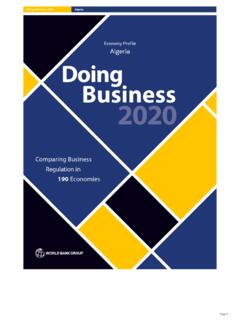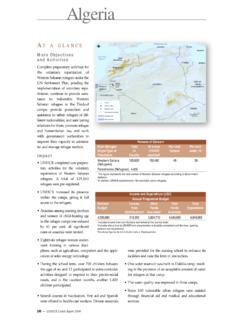Transcription of MPC – MIGRATION POLICY CENTRE
1 MPC MIGRATION POLICY CENTRE . Co-financed by the European Union MPC - MIGRATION PROFILE. algeria The Demographic-Economic Framework of MIGRATION The Legal Framework of MIGRATION The Socio-Political Framework of MIGRATION Report written by the MPC Team on the basis of CARIM South database and publications June, 2013. 2013. All rights reserved. No part of this paper may be distributed, quoted or reproduced in any form without permission from the MPC. 03& 0 LJUDWLRQ 3 URILOH $/*(5,$. The Demographic-Economic Framework of MIGRATION In 1973, after the mass emigration wave towards France in the 1960s, the Algerian government, relying on its oil and hydrocarbon revenues, unilaterally decided to put a halt on outward MIGRATION , which was considered a form of post-colonialism.)
2 For almost three decades afterwards, there was no mass emigration from algeria , neither labour-driven despite constant unemployment nor forced notwithstanding the tragic events in that country in the 1990s. In that period, what emigration there was, came as a r esult of French family-reunification schemes. As to emigrants abroad, their return home was not supported, since they were considered a safety valve for algeria 's local labour market (Fargues, 2006). Since the 2000s, a new upsurge of Algerian labour emigration has been o bserved in concomitance with the gradual liberalization of the Algerian economy which, however, still has high unemployment, especially among the highly-skilled. This new wave of emigration, indeed, has a qualified emigrant profile, together with diversification in the choice of destination country.
3 As to immigration patterns, mixed inward flows have been a c onstant in the history of algeria . True, almost all European migrants (settled in algeria during the colonial period) returned home at independence in 1962 and the medium- and highly-skilled migrants called in by the Algerian state in the framework of its technical cooperation with Eastern Europe and some Arab countries in the 1960s and 1970s also returned. But, since the 2000s, algeria has experienced a new type of immigration, as a result of economic liberalization. Today, growing numbers of foreign firms and workers enter algeria , especially from China (in the construction sector) and India (in the steel industry). Meanwhile, algeria continues to play a r elevant role in attracting Sub-Saharan migrants destined to cover labour shortages in a variety of sectors ( agriculture, construction, tourism, domestic services, etc.)
4 During the 2011 Libyan Civil war, algeria was officially the neighbouring country that received fewest migrants fleeing Libya: 12,296 third-country and 1,666 Algerian nationals reached Algerian borders from February to November 2011 (IOM data). Official figures are perhaps inaccurate here though. International agencies were often kept away from Algerian transit border areas. And the United Nations High Commissioner for Refugees (UNHCR) reported that in March 2011, it was contacted directly by the Senegalese embassy worried about 300 Senegalese nationals who were refused entrance to algeria by the Algerian authorities at the border with Libya (UNHCR, 2011). Outward MIGRATION Inward MIGRATION Stock Stock In c.
5 2012, 961,850 Algerian migrants resided abroad, According to the 2008 Census there were 95,000. that is of the population residing in algeria . foreign residents in algeria , or of the total Algerian emigration stocks by country of residence, most recent data (c. 2012). resident population. Country of Definition Reference Source Number %. residence (a) date (Jan 1st) Foreign population residing in algeria by country of European Union 877,398 nationality, 1998, 2008. of which France (A) 2009 Population Census 721,796 1998 2008. Country of nationality S pain (A) 2012 Population Register 60,207 Number % Number It aly (A) 2012 Population Register 23,278 Arab countries 57,599 UK (A) 2012 Annual Population Survey 22,000 of which Morocco 18,661 Southern-Eastern Mediterranean (SEM) countries (b) 11,209 Tunisia 8,389 of which Tunisia (B) 2004 Population Census 9,612 Egypt 5,943 Other countries (c) 73,243 of which Canada (A) 2006 Population Census 33,515 UAE 4,143 US (A) 2011 American Community Survey 17,068 Non-Arab African countries 7,134 Main total 961,850 of which Mali 4,162 (a).
6 Algerian migrants are defined according to the country of birth (A) or country of nationality criterion according Non-Arab Asian countries 1,597 to countries of residence. (b): SEM countries include Egypt, Jordan, Lebanon, Mauritania, Morocco, Palestine, Sudan, Syria, Tunisia and European countries 5,021 Turkey. of which France 2,618 (c): "Other countries" include other European countries (Armenia, Belarus, Georgia, Iceland, Liechtenstein, Moldova, Norw ay, Russia, Sw itzerland and Ukraine), Australia, Canada, Chile, Israel, Japan, Mexico, New Zealand Other countries and stateless 258 and United States. Main total 71,609 95,000. Sources: national statistics (Population Censuses, population registers, registers for foreigners, etc.)
7 % of the total resident population Source: Algerian population census (1998 and 2008). MIGRATION POLICY CENTRE ( ) . 1. 03& 0 LJUDWLRQ 3 URILOH $/*(5,$. The majority lived in the European Union Both absolute and relative values show no especially in France ( ) and Spain ( ) and relevant changes between the two Censuses in other countries ( ), particularly in Canada (71,609 vs 95,000 and vs from 1998. ( ). In the last decade, destinations for Algerian to 2008, respectively). 1998 data reveals how most migrants diversified. In particular, the importance of foreign nationals came from other Arab countries Canada and Spain as new destinations for Algerian ( ) especially other Maghreb States (Morocco, emigrants emerged strikingly.))
8 For instance, the and Tunisia ) and Egypt ( ) as well number of Algerian migrants residing in Spain as from Mali ( ) and European countries between 2002 and 2012 almost doubled, meaning an ( ). This is worth mentioning as in the 1998. annual average growth rate of In Canada, Census, only of the foreign-born population between 2001 and 2006, the same value stood at declared a foreign nationality: until 2005, dual After France, these two countries host, today, citizenship was not allowed (Musette, 2010). the largest Algerian migrant communities. Flows As to their profile, in OECD countries (circa 2006), Algerians are more likely to have a low level of Work permit data allows for a better understanding education ( ) and an intermediate occupational of the recent evolution of labour immigration in profile (almost one i n three are employed algeria .
9 In the 2000s, an upsurge in labour as technicians or professionals, as craft and immigration was observed. related trade workers or as service and m arket sale workers and 14. 1% in elementary occupations). Work permits granted to foreign nationals, 2003-2012. ( ). This profile is largely explained by the 60,000. relative age of the Algerian diaspora. Actually, the 50,000. profile of Algerians residing in France has substantially improved: from 1999 ( Census) to 2008 40,000. (Enqu te Emploi) those with a tertiary education 30,000. passed from to , while those with an 50,760. 20,000. intermediate level went up from to 23,000. However, the period of emigration cannot alone 10,000 18,000 18,191.
10 10,564 6,963. explain the emigrant profile. For instance, as noted by 0. 1,107 5,190. Fargues (2011), considering two recent outward flows 2001 2002 2003 2004 2005 2006 2007 2012. namely, Algerians directed to the US and Spain Source: Agence Nationale de l'Emploi (ANEM) - algeria while the Algerian community is among the most educated in the US ( average years of schooling From 2001 to 2012, the number of work vs registered both by other foreign-born permits rose from 1,107 to 50,760. communities and US-born), in Spain it registers lower Work permits granted to foreign nationals by country of citizenship and by sector of occupation (% values), 2006. 2004. levels of education ( average years of schooling).

